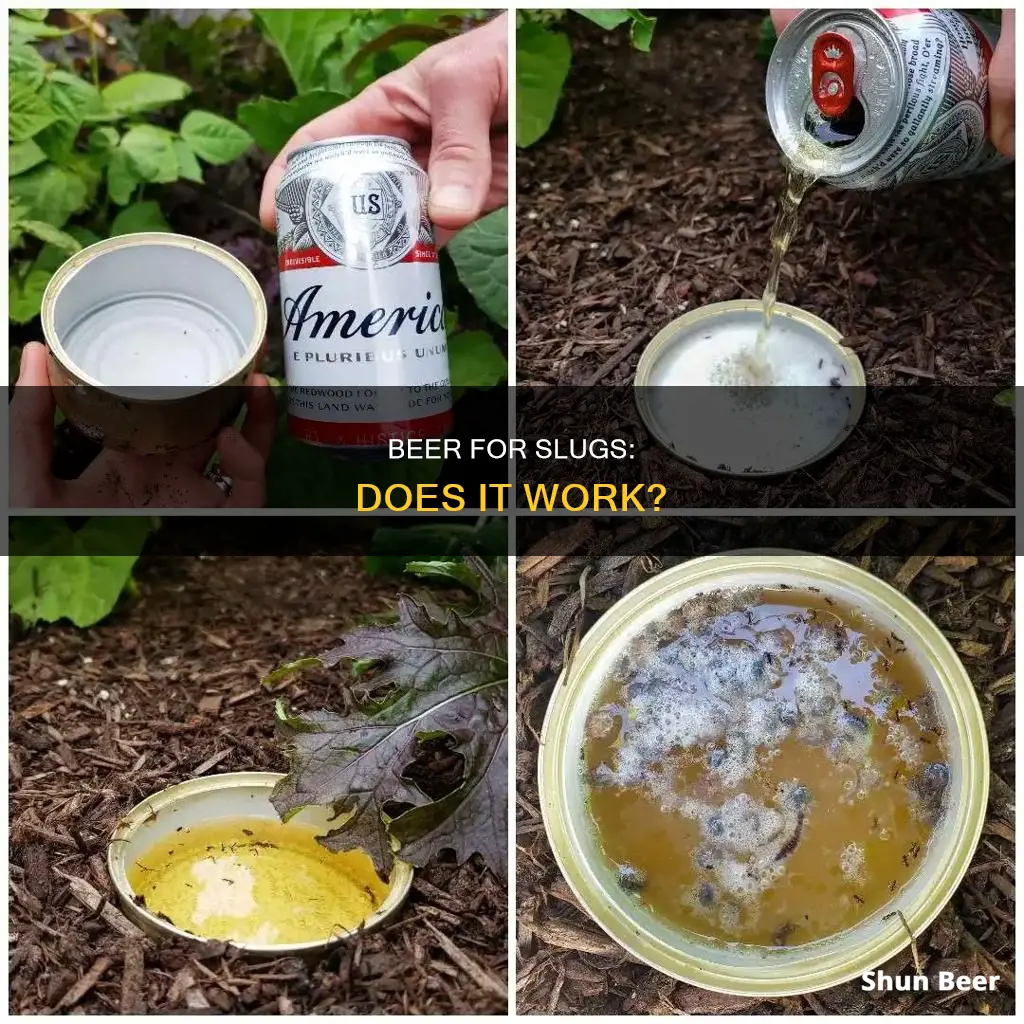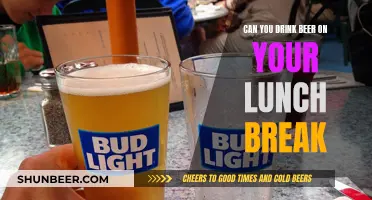
Beer traps are a popular method for getting rid of slugs and snails in gardens. The idea is that slugs are attracted to the smell of malt in beer, fall into a small dish of beer, and drown. While this method does work to some extent, it is not a perfect solution. Most slugs that visit the trap drink some beer and continue on their way, while some even climb out of the trap. Additionally, the odor of malt can attract slugs from a distance, increasing the slug population in the area. However, by placing the trap away from plants and cleaning and topping it up every few days, it is possible to see a decrease in the slug population over time.
| Characteristics | Values |
|---|---|
| Effectiveness | Beer traps are effective in attracting slugs, but not in killing them. |
| Distance | Beer traps only attract slugs within a few feet. |
| Slug Behaviour | Most slugs will drink the beer and leave. A few will fall in and drown. |
| Slug Attractant | Slugs are attracted to the yeast or yeast by-products in beer. |
| Container Type | Containers should be wide and shallow, with rims at least 1" above soil level. |
| Container Placement | Containers should be placed in the shade, under slug-prone plants. |
| Beer Type | Light, yeasty beers like lagers are preferred by slugs. |
| Alternative Attractants | Sugar, baking yeast, and sourdough starter are also effective attractants. |
What You'll Learn

How to make a beer trap for slugs
Beer traps are an effective way to get rid of slugs in your garden. Slugs and snails are attracted to the yeasty, fermented odour of beer and will make their way to it instead of your plants.
Step 1: Choose a Container
Select a small container, such as a plastic cup, a yogurt pot, or even an old china cup. You can also use a plastic bottle by cutting off the bottom and using it as a tray. The container should be able to hold at least 2-3 inches of beer.
Step 2: Prepare the Container
If using a container with a lid, cut a few holes around the top edge for the slugs to crawl through. The lip of the container should be kept at least 1 inch above the ground to prevent beneficial insects from falling in.
Step 3: Dig a Hole
Dig a small hole in the area of your garden where slug activity is the greatest. Place the container in the hole and fill in the soil around it, leaving an inch or less (2-2.5 cm) of the container above the soil level.
Step 4: Add Beer
Pour 2 to 3 inches (5 to 7.5 cm) of beer into the container. Any type of beer will do, and it doesn't have to be expensive. You can even use non-alcoholic beer.
Step 5: Check and Refill
Check the traps daily and add more beer as needed. The beer may need to be changed less frequently if using a lidded container, as it will be protected from rain.
Step 6: Dispose of Slugs
Remove dead slugs from the traps and dispose of them as desired. You can put them in the compost, leave them for slug predators like birds and toads, or simply toss them into your garden soil, where they will quickly dry up and wither away.
It is important to note that beer traps only attract slugs within a short distance, so you may need multiple traps placed about a metre apart to effectively protect your plants. Additionally, the odour of malt can attract slugs from afar, increasing the slug population in your garden. Therefore, it is recommended to place the traps away from plants that are susceptible to slug damage.
Beer Butt Chicken: Does It Work?
You may want to see also

The effectiveness of beer traps
Beer traps are a popular method for getting rid of slugs and snails in gardens. The idea is that slugs and snails are attracted to the smell of beer, fall into a small container of beer, and subsequently drown.
There is some truth to the claim that beer traps work. Time-lapse videos show that slugs are indeed attracted to beer and will go for a sip. Some even fall into the trap and drown, which is what gardeners want. However, the majority of slugs that visit the trap simply drink some beer and continue on their way without any negative consequences. A few even wallow in the beer and then climb back out.
To optimize the effectiveness of beer traps, it is recommended to place the traps as far as possible from the plants that are susceptible to slug damage. This will draw slugs away from valuable plants and into areas where their leaf-eating is not a problem. It is also important to use multiple traps placed about every square yard (or meter) in areas with high slug activity.
When setting up a beer trap, it is best to use inexpensive or light, yeasty beers such as lagers, pilsners, or blonde ales. Any container that can hold a couple of inches of beer will work, including recycled containers like yogurt pots, cut-up plastic bottles, or mason jars. Partially bury the container so that the rim is level with or just above the soil surface, leaving enough space for slugs to crawl in. Fill the container about one-third to half full with beer, and be sure to refresh the beer every couple of days as it will attract fewer slugs and evaporate over time.
Do Sulfite Wands Really Work for Beer?
You may want to see also

Why slugs are attracted to beer
Slugs are attracted to beer, and it is a popular belief that a simple beer trap can help keep these pests away from plants. The trap is easy to set up: take a small dish or bowl, fill it with beer, and place it in the ground. The slugs, attracted by the smell of malt, will supposedly fall into the dish and drown.
However, time-lapse videos have shown that most slugs that visit the trap will drink some beer and then continue on their way. Some even climb into the trap, wallow in the beer, and then climb back out. Only a small minority of slugs drown in the beer. It is unclear why some slugs drown while the majority do not.
The odour of malt in beer attracts slugs from afar, increasing the local slug population and resulting in more damage to plants. Therefore, placing slug beer traps near plants may not be effective in protecting them. However, placing the traps away from plants may help draw slugs to areas where their leaf-eating is not a problem.
So, why are slugs attracted to beer? It is not the alcohol but the yeast or yeast by-products that lure these slimy creatures. Slugs seem to prefer the smell of fermented vegetable matter to fresh plants. They are also attracted to other fermented products like yeast solutions and bread dough, which has been found to be an even better attractant than beer.
Hoppy Beers: The Secret to Better Beer Bread?
You may want to see also

Other methods to get rid of slugs
Slug traps are not the only way to deter slugs from your garden. Here are some alternative methods:
- Create a healthy ecosystem: Encourage slug predators such as birds, newts, frogs, toads, and slow worms into your garden by installing a wildlife pond, hedges, shrubs, and trees.
- Create a slug-free zone: Use fabric or mesh at the base of your pots so that slugs can't gain entry from underneath them. Delay planting seedlings until they have reached a decent size, as they are more likely to withstand slug damage.
- Pick them off: Go out with a torch after dark to pick slugs off your plants. Wear gloves and use a bucket of saltwater to dispose of them.
- Water in a biological control: Many organic gardeners use biological controls that contain microscopic nematodes. These infect slugs with bacteria and then kill them.
- Copper rings: Copper rings can be effective deterrents – if a slug tries to cross one, it receives an 'electric shock', forcing it back.
- Welcome predators: Toads, turtles, garter snakes, possums, hedgehogs, and raccoons all enjoy eating slugs, so consider how you can attract them to your garden.
- Grow resistant crops: Outsmart slugs by landscaping with plants they dislike, such as lavender, rosemary, wormwood, catmint, and sage.
- Create a barrier: Surround vulnerable plants with a barrier that harms slugs, such as diatomaceous earth.
Antibiotics and Beer: A Safe Mix?
You may want to see also

Other pests attracted to beer traps
Beer traps are an effective way to attract and eliminate slugs and snails in your garden. The pests are attracted to the fermented drink, which, when placed in a shallow dish, results in them falling in and drowning. However, beer traps also attract other pests, including:
Cockroaches
Cockroaches are lured by the smell of beer. A trap can be made by coating the inner lip of a jam jar with Vaseline and placing a slice of beer-soaked bread at the bottom. The Vaseline acts as a barrier, preventing the cockroaches from escaping once they are attracted to the beer.
Fruit Flies
Fruit flies are drawn to fermented food and alcoholic beverages. A simple trap can be made by placing a sheet of paper with a small hole over an open can or bottle of beer. The flies will be attracted to the beer and fly in, but will be unable to escape.
Earwigs
Earwigs can cause damage to plants and lawns. They can be trapped using the same methods as slugs and snails, by placing a shallow dish of stale beer close to the ground.
Moths
The sugar and smell of beer attract moths.
Mice
Mice are also attracted to beer. A humane trap can be created by pouring beer into the bottom of a bucket and placing a ramp for the mice to climb up and reach the beer. Once they leap in, they will be unable to climb back out, and you can release them outside.
Beer Fast: Does It Work Quickly?
You may want to see also







